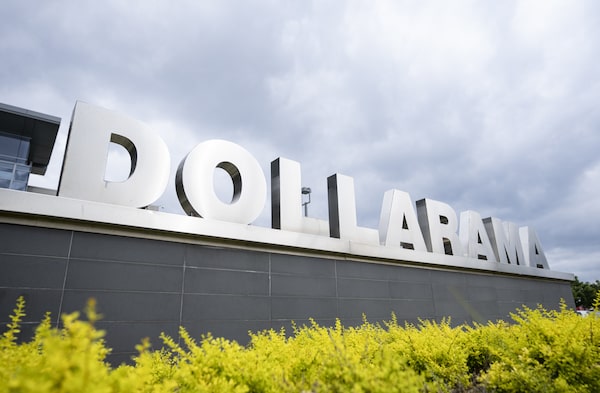
Dollarama head offices are seen in Montreal on June 7, 2023.Christinne Muschi/The Canadian Press
Dollarama Inc. DOL-T reported a 31.4-per-cent increase in profit in its third quarter, as Canadians continue to turn to discount stores looking for some relief from the pressures of inflation.
This has been a trend for Dollarama, which stocks products at prices up to $5 and has had significant sales increases over the past two years. The Montreal-based discount retailer reported on Wednesday that comparable sales – an important industry metric that tracks sales growth not tied to new store openings – grew by 11.1 per cent in the quarter ended Oct. 29. That marked the sixth consecutive quarter in which comparable sales grew by a double-digit percentage.
While on average, the size of shoppers’ baskets on each trip are only slightly higher than they were a year ago, people are visiting discount stores more often. Dollarama reported that the number of transactions at its stores increased 10.4 per cent in the quarter.
The company’s net earnings grew to $261.1-million or 92 cents a share in the 13 weeks ended Oct. 29, compared to $201.6-million or 70 cents in the third quarter the prior year.
Sales are up across product categories, and people continue to buy more “consumables” than usual at Dollarama, such as food and household products.
But competition for those shoppers is ramping up as other retailers push back with their own discounted prices on those consumable products, chief executive officer Neil Rossy said on a conference call Wednesday to discuss the financial results.
“On core consumables, we are seeing that the market is becoming more competitive,” Mr. Rossy said. “Extremely competitive, in fact.”
Some of Dollarama’s costs rose: Its general, administrative and store expenses grew by 17.6 per cent in the third quarter compared to the same period the prior year, as store labour costs were up and the timing of some other operating costs fell within the quarter. But the company’s profit margin expanded, as costs to ship products into the country decreased, as did logistics expenses.
Sales grew by 14.6 per cent to nearly $1.5-billion. The increase owed to both new store openings – Dollarama had 1,541 as of the end of October, compared to 1,462 a year earlier – and sales growth at existing stores.
Dollarama has opened 55 net new stores so far this fiscal year, and is on track to meet its goal of opening 60 to 70 new locations by the end of the year, Mr. Rossy said.
On Wednesday, Dollarama boosted its sales outlook for the year, predicting that comparable store sales will increase by 11 to 12 per cent for the fiscal year ending Jan. 28. Its previous outlook, provided in mid-September, predicted comparable sales would grow by 10 to 11 per cent for the year.
While Dollarama benefits from a tight economic environment, where consumers are looking for discounted products – a habit known in the industry as “trading down” – Mr. Rossy noted that the retailer is not overly reliant on inflationary pressures to drive its business.
“Consumers tend to look at Dollarama as a solution to having to trade down, and when the market and the economy are strong, there are just more dollars to spend. So Dollarama gets its share of those dollars, even if the percentage is smaller than it would be when there’s a trade down,” Mr. Rossy said. “I think that’s part of the strength of our business model, is that it’s resilient on both sides.”
 Susan Krashinsky Robertson
Susan Krashinsky Robertson